Alaska Economic Trends
Alaska Economic Trends is a monthly magazine that covers a range of economic topics.
Sign up for a free electronic subscription. 
Sign up for a paid print subscription.
Alaska Economic Trends are searchable from 1961 to the present using the Trends search page. The search can include any combination of the following: Key Words, Date Range, Author, Category
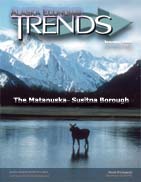
The Matanuska-Susitina Borough has received a lot of attention in this past ten years for its rapid growth. In reality, it grew at an even faster rate during the prior three decades. During the most recent period, no other area of the state came close to the borough's track record of population and employment growth.
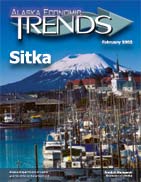
Sitka is located on the outer coast of Baranof Island in central Southeast Alaska. Home to the Kiksadi clan of Tlingits, it was 'discovered' by the Vitus Bering expedition of 1741. In 1799, Alexander Baranof built a Russian-American Company...

At the low point of the Great Depression in 1935, the United States adopted a number of policies designed to alleviate economic distress in the country. Among them was Unemployment Insurance (UI), instituted to mitigate the hardships of temporary unemployment and to introduce a degree of economic stabilization...
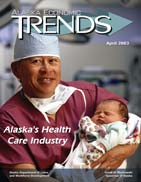
The health services industry is the fastest growing, and one of the larger sectors of Alaska's economy. It's a billion-dollar industry, and it employs about 22,000 people. It would be hard to find an industry in Alaska with a growth pattern as strong and sustained as that of health care.
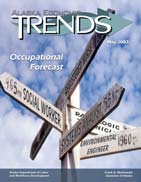
Change is a fact of life, and a vital factor in the economy. With advances in technology, shifts in demographics, and improvements in business practices, the mix of occupations that make up the economy is constantly evolving, and so too must the training and skills of Alaska's workforce.

Youth enter the workforce with limited skills and little previous employment experience. The experience and skills young workers develop on their first jobs can prepare them for a successful, long-term career. This article examines the numbers, occupations, employers, place of work, and wages of Alaska's working youth. Also discussed are how to go about looking for work and some of the qualities Alaska's employers seek.
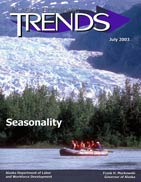
Alaska's economy is highly seasonal, compared to states in more southern latitudes. In the cold of winter, industries such as construction, seafood processing, and tourism shift into lower gear. Yet, to answer questions such as: What portion of Alaska's economy is seasonal? and Which occupations are seasonal? is no simple task.
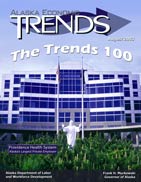
For the second year in a row, Providence Health System Alaska topped the list of Alaska's 100 largest private employers. Its workforce numbered 3,417 in 2002. The Medical Center in Anchorage has the lion's share of Providence's employment, but the company has also grown by acquiring and partnering with other health care facilities in Anchorage and elsewhere in the state.
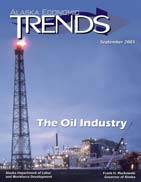
Oil has played central roles in Alaska's economy and psyche since 1957, when the Kenai fields were discovered. The economic implications of this find were important in the statehood movement and Alaska's admission to the Union. In 1968, the discovery of the massive Prudhoe Bay field ushered in a new era of prosperity for Alaska. The jobs directly created by the oil industry have never been great in number, but they remain some of the most sought after in the state's labor market.

On September 5, 2000, the Marine Stewardship Council certified Alaska's statewide commercial salmon fisheries program as well managed and sustainable. Alaska's was the only salmon fishery in the world to meet the council's rigorous environmental standards and earn this distinction. Yet even as Alaska's preeminence in biological management was being recognized, Alaska's salmon fishermen had fallen on hard times.
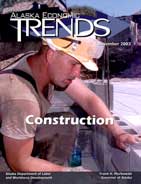
Construction activity is often regarded as an economic bellwether. Its performance is a billboard for consumer confidence particularly the residential and commercial building sector. Changes in the level of construction activity often signal a change in the economic climate of an area, state or nation. Because of this, the industry's performance often serves as a barometer of future economic wellbeing.
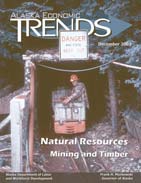
Alaska's economy has always relied upon its rich natural resources. From the days of the Treadwell mine and the later Klondike gold rush to the development of the Prudhoe Bay oil fields, many Alaskans have earned their living by extracting Alaska's mineral wealth. Many others have been employed cutting timber and harvesting seafood.
